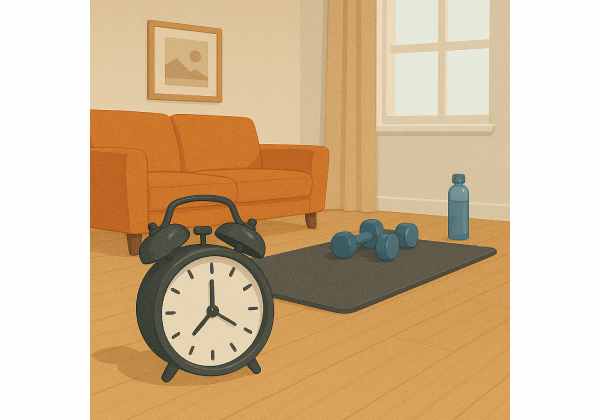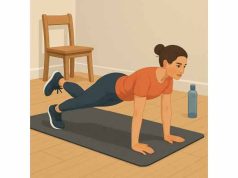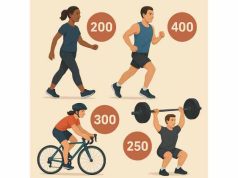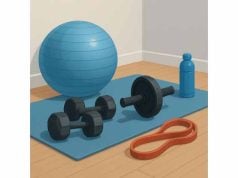
You can change your week with thirty focused minutes. When time is tight, short training blocks keep momentum, elevate daily energy burn, and protect muscle while you lose fat. This guide gives you ready-to-use 30-minute templates, clear intensity targets, and weekly schedules that fit real life. You’ll see how to train at home or in the gym, how to progress without aches, and how to troubleshoot plateaus. If you’re assembling a broader plan, scan our primer on exercise choices for weight loss to balance strength, cardio, and steps.
Table of Contents
- Do 30-minute workouts burn fat?
- 30-minute fat-burning template
- Home vs gym options
- Weekly schedules that fit
- Progressions and variations
- Common mistakes and fixes
- Safety: who should modify
- Frequently Asked Questions
Do 30-minute workouts burn fat?
Thirty minutes is enough—when you choose the right levers. Fat loss happens when weekly energy expenditure exceeds intake. Short sessions help by (1) creating a repeatable training habit, (2) preserving or building muscle to keep your metabolic rate higher, and (3) nudging up non-exercise activity because you feel better the rest of the day.
Why thirty beats “nothing or everything.” Long workouts are great, but they’re not required. A consistent 30-minute routine (3–5×/week) can match or beat scattered long sessions because you show up more often and recover faster. Consistency also makes nutrition steadier—no “make-up day” extremes.
What makes a 30-minute workout “fat-burning.”
- It emphasizes large muscle patterns (squat, hinge, push, pull, carry) to raise total work.
- It manages intensity so you can finish strong without wrecking technique.
- It fits next to your life, so you repeat it on busy days—not just ideal ones.
A simple framework that works. Pair strength intervals (time-boxed sets with short rests) with brief cardio intervals to keep heart rate up without turning strength into sloppy cardio. Think “move well first, then move faster.”
Calorie burn and expectations. A half hour can expend roughly 180–400+ calories, depending on body size, pace, exercise choice, and rest. Those numbers are estimates; the bigger win is muscle retention and a routine you’ll keep during a calorie deficit. A realistic fat-loss rate for many adults is 0.25–0.75 kg (0.5–1.5 lb) per week on average when training supports, not sabotages, nutrition.
When thirty minutes isn’t enough—by itself. If steps and food drift, a single session won’t fix the week. Keep daily movement high (walks, breaks, chores) and anchor meals around lean protein, plants, and slow-digesting carbs. For context on safe pacing and expectations, skim our guide to healthy weight-loss basics.
Bottom line: Thirty minutes is plenty to move the needle when you train with intent and guard recovery. Use the templates below, track weekly averages, and progress patiently.
30-minute fat-burning template
This is your plug-and-play structure for any environment. It balances strength and conditioning while protecting form.
Total time: ~30 minutes
- Warm-up (5 minutes)
- Easy cardio 2 minutes (walk, cycle, row).
- Dynamic prep: hip hinges, ankle rocks, arm circles (6–8 reps each).
- Two 20–30-second “primers” at a brisk pace with equal easy recovery.
- Strength Intervals (16 minutes) — two mini-circuits, work 40s / rest 20s × 8 rounds (alternate A1/A2, then B1/B2). Choose loads that keep 2 reps “in reserve.”
- A1: Squat pattern (goblet squat / sit-to-stand)
- A2: Push (push-up / machine press)
- B1: Hinge (kettlebell deadlift / hip hinge)
- B2: Pull (row variation: dumbbell, cable, band)
- Finisher (6–7 minutes) — choose one
- Cardio repeats: 30s hard / 30s easy × 6–7 on bike, rower, or fast walk on incline
- Mixed modal: 20s kettlebell swings + 40s easy walk × 6
- Bodyweight burst: 30s step-overs + 30s shadow boxing × 6
Intensity guardrails
- Strength rounds: RPE 7–8/10 (challenging, crisp technique).
- Finisher: RPE 8–9/10 during hard bouts, back to RPE 3–4/10 on recovery.
- If form slips, extend the next rest by 10–20 seconds or reduce load.
Why this template works
- Hits every major pattern for high return on time.
- Alternating upper/lower reduces local fatigue, letting heart rate stay up.
- Short, focused finisher provides a conditioning hit without dominating the session.
Customization ideas
- Prefer a pure cardio day? Run the finisher for 12 minutes with a longer cooldown.
- Need more strength? Make intervals 45s work / 15s rest and shorten the finisher.
- Love steady aerobic work? Swap the finisher for 8–10 minutes Zone 2 to build a broader base; for comparisons, see HIIT versus steady cardio.
Tracking: Note loads, reps left in reserve, and finisher pace/speed. When all rounds feel tidy, add 2–5% load, one interval, or a touch of finisher intensity—only one change at a time.
Home vs gym options
You can run the same 30-minute structure almost anywhere. Below are ready-to-use choices for bodyweight, bands, dumbbells, and common machines.
At home: bodyweight or bands
- Warm-up: march or stair walk, hip hinges, shoulder CARs.
- Strength Intervals (16 min):
- A1: Sit-to-stand or bodyweight squat
- A2: Incline push-up on counter (elevate hands to scale)
- B1: Hip hinge good-mornings (hands on hips) or band RDL
- B2: Band row or isometric towel row (pull for 15–20s per 40s window, reset)
- Finisher (6–7 min): 30s step-overs / 30s easy march × 6–7
At home: dumbbells
- Strength Intervals:
- A1: Goblet squat
- A2: One-arm floor press (switch sides each round)
- B1: Romanian deadlift
- B2: One-arm row (bench or hip-hinge support)
- Finisher: 20s kettlebell/dumbbell swings + 40s walk × 6–7
If you want a fuller strength plan to pair with these sessions, browse our simple at-home dumbbell plan.
In the gym: machine-friendly
- Bike or rower finisher keeps joints happy and intensity repeatable.
- Cable stacks simplify rows and presses; leg press can sub for squats on cranky-knee days.
- Sled pushes work as a stand-alone finisher: 20–30m push / walk back easy × 6–8.
Movement quality cues
- Squat to a target to standardize depth.
- Keep ribs down on presses; exhale gently through the sticking point.
- Hinge with soft knees and long spine; feel hamstrings load before you move.
- Rows: drive elbow to back pocket, pause briefly, control down.
Space-saving swaps
- No step or box? Use a floor tape line for step-overs.
- No bands? Replace with isometric towel rows (pull into an unmoving anchor).
- No weights? Tempo and range tweaks (3-second lowers, 1-second holds) raise stimulus without load.
Weekly schedules that fit
Program the week like a budget: enough stimulus to progress, enough recovery to repeat. Most busy adults thrive on three to five 30-minute sessions with daily movement.
Three-day plan (foundation)
- Mon: 30-minute strength-interval template
- Wed: 30-minute cardio emphasis (longer finisher or steady Zone 2)
- Fri: 30-minute strength-interval template (different exercises)
Four-day plan (balanced)
- Mon: Strength-intervals (lower emphasis)
- Tue: Cardio finisher focus (bike/rower repeats)
- Thu: Strength-intervals (upper emphasis)
- Sat: Mixed intervals (sleds, swings, or incline repeats)
Five-day plan (short, frequent)
- Mon–Fri: Alternate strength-interval days and cardio-finisher days; keep at least one low-intensity day if life stress runs high.
Where steps and NEAT fit
- Short walks (5–15 minutes) between meetings, after meals, or on calls maintain daily burn and digestion. If office life pins you down, see our practical desk-movement ideas to stay active.
Recovery anchors
- Protein with each meal, 7–9 hours sleep, and gentle mobility on off days.
- Protect at least one recovery day weekly. When fatigue creeps in, drop a finisher or extend rests before adding rest days.
When to push vs. hold
- Push (add load or interval) when: technique is crisp, RPE is moderate, sleep/appetite are steady.
- Hold (repeat the same plan) when: work is chaotic, sleep dipped, or joints feel grumpy. Steady repeats still drive progress.
For help spacing harder and easier days, our brief guide to rest-day planning shows simple patterns that keep momentum.
Progressions and variations
Progress slowly so joints adapt and motivation stays high. Change one variable at a time—load, volume, density, or complexity.
Simple progressions (choose one per week)
- Load: add 2–5% to goblet squats, presses, rows when all rounds stay tidy.
- Volume: add one interval to a mini-circuit (from 8 to 9 total).
- Density: keep work time the same but reduce rest by 5–10 seconds.
- Complexity: swap in a slightly more demanding variation (front-foot-elevated split squat, half-kneeling press).
Cardio finisher progressions
- Increase speed/watts, not flail.
- Add one round or extend hard efforts by 5–10 seconds while keeping recovery honest.
- Alternate modalities weekly (bike → rower) to spread stress.
Movement variations to keep training fresh
- Squat: goblet → double DB front squat → tempo squat (3-1-0).
- Hinge: RDL → KB deadlift from deficit → hip hinge with 2-second pauses.
- Push: incline push-up → floor press → DB bench press.
- Pull: one-arm row → chest-supported row → cable row with 1-second hold.
- Carry: suitcase carry (20–30m) between circuits for bonus core.
Strategic substitutions
- If equipment is scarce, run unilateral versions (split squats, one-arm presses) to raise challenge without adding load.
- If knees complain, bias hinges, hip thrusts, step-ups, sled pushes.
- If lower back is sensitive, choose chest-supported rows and goblet squats; keep hinges lighter with slow intent.
If you enjoy high-effort intervals on tight days, pair these templates with a quick session from our 20-minute HIIT collection—use it as a substitute, not an add-on, when stress is high.
Common mistakes and fixes
Mistake 1: Turning strength into frantic cardio.
Fix: Use loads that keep technique crisp. If you’re gasping, extend rest or reduce reps; the goal is quality tension, not random fatigue.
Mistake 2: Chasing soreness as proof.
Fix: Track progress by performance (load, pace, control), energy, and adherence. Mild soreness is fine; debilitating soreness kills consistency.
Mistake 3: Ignoring warm-ups.
Fix: Keep a five-minute flow you actually do: easy cardio, hinges, ankle rocks, arm circles, two brisk primers. Small investment, big payoff.
Mistake 4: Skipping recovery.
Fix: Protect sleep, spread protein through the day, and plan one lighter day weekly. If heart rate or mood is off, drop one finisher and reassess.
Mistake 5: Copy-pasting someone else’s split.
Fix: Organize around your constraints (childcare, commute, travel). Thirty focused minutes that happen beat “perfect” workouts that don’t.
Mistake 6: All HIIT, no base.
Fix: Mix intensities. Keep one easy aerobic session weekly (or extend cooldowns). A broad base makes hard work easier.
For warm-ups that take three minutes and actually help, see our quick guide to warm-up and recovery.
Safety: who should modify
Most healthy adults can train safely with the templates above. Adjustments matter if you’re new, managing joint pain, or returning after illness or pregnancy.
New or returning exercisers
- Start with two or three 30-minute sessions/week.
- Keep strength loads at RPE 6–7/10, finishers at RPE 7–8/10.
- Choose low-impact finishers (bike, incline walk, row).
Higher body mass or joint sensitivity
- Favor goblet squats to a box, RDLs, presses, rows, and sled pushes.
- Shorten work to 30–35 seconds and lengthen rests to 25–30 seconds.
- Use softer surfaces and supportive shoes.
Older adults
- Prioritize balance (heel-to-toe walks, sit-to-stands) and controlled tempo.
- Machines (bike, cable row, leg press) can reduce joint flare-ups.
- Keep sessions consistent, not maximal.
Pregnancy and postpartum
- Many can continue strength and cardio with talk-test intensity; avoid overheating and high-impact drills if advised.
- Postpartum: rebuild with breath and pelvic-floor coordination first; progress loading gradually.
Medical considerations
- If you have cardiovascular, metabolic, or orthopedic conditions—or take medications affecting heart rate or balance—get personalized clearance. Use effort cues over strict heart-rate formulas when meds interfere.
Prefer joint-friendly conditioning? These low-impact cardio options keep intensity up while impact stays down.
Frequently Asked Questions
Are 30-minute workouts enough to burn fat?
Yes. Three to five 30-minute sessions per week, anchored by big-muscle lifts and brief intervals, can support a steady calorie deficit and preserve muscle. Pair training with daily steps and protein-forward meals for reliable progress. Consistency and recovery drive results more than marathon sessions.
How should I structure a 30-minute fat-burning workout?
Use five minutes to warm up, sixteen minutes of strength intervals (two moves alternated, then two more), and a six-to-seven-minute finisher. Keep work quality high, rest short but honest, and end with an easy cooldown. Track loads and pace so you can progress gradually.
What’s better in 30 minutes—HIIT or steady cardio?
Both work. For time-crunched days, short intervals raise intensity efficiently. Across a week, combine them: two strength-interval days with brief finishers and one easier steady session. Mixing intensities builds fitness, protects joints, and keeps training psychologically fresh.
How many calories does a 30-minute workout burn?
It varies by size, exercises, effort, and rest. Many 30-minute sessions land around 180–400+ calories. Treat device numbers as estimates; judge success by performance, adherence, and body-composition trends. Muscle-preserving strength work often beats chasing the highest burn per session.
Can beginners use these templates?
Yes—start with lighter loads, fewer intervals, and low-impact finishers. Keep intensity at a “hard but repeatable” level and stop sets if form fades. Two to three weekly sessions are plenty initially; add a fourth day only when you recover well.
How do I avoid getting too sore with short, hard sessions?
Stay a little shy of failure, pick sensible progressions, and rotate variations. Keep your warm-up brief but real, prioritize sleep and protein, and insert a lighter week every four to six weeks. Excess soreness usually signals too much, too soon—or inconsistent recovery.
References
- WHO guidelines on physical activity and sedentary behaviour 2020 (Guideline)
- Physical Activity and Exercise During Pregnancy and the Postpartum Period | ACOG 2020 (Guideline)
- 2024 Adult Compendium of Physical Activities: A third update of the energy costs of human activities 2024 (Systematic Review)
- High-intensity interval training is not superior to continuous aerobic training in reducing body fat: A systematic review and meta-analysis of randomized clinical trials 2023 (Systematic Review)
- Resistance training effectiveness on body composition and body weight outcomes in individuals with overweight and obesity across the lifespan: A systematic review and meta‐analysis 2022 (Systematic Review)
Medical Disclaimer
This article shares general fitness and nutrition information and is not a substitute for personalized medical advice. Consult your healthcare professional before starting or changing an exercise or weight-loss program, especially if you have medical conditions, are pregnant or postpartum, or take medications affecting heart rate, blood pressure, or balance.
If this guide helped you, consider sharing it with someone who trains on a tight schedule. You’re welcome to follow us on Facebook or X for practical templates and steady, evidence-based advice.










